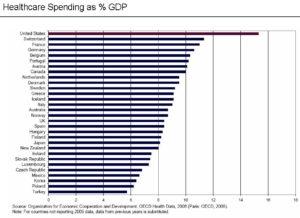Why healthcare is so expensive

Let’s say that you and two friends go to a Mexican restaurant for dinner. After reviewing the menu, you ask the waiter how much is a pitcher of Margaritas as the price isn’t listed.
The waiter pauses for a second and says that he can’t tell you, but you’ll know when you get the bill!
When you press him, he says the price of the pitcher depends of who is paying. It’s either $80, $65 or $6.75! How is that possible?
It’s possible as that is our healthcare system in a nutshell. Not only do the people who provide it don’t want to tell you how much you’re paying ahead of providing services, but they’ll potentially send your share to collections without telling you what your share is ahead of time.
If you’re out-of-network, it’s $80, paying cash, $65 and if the doctor/hospital/clinic has an agreement with the insurance company or in-network (meaning that they’ll take a few cents on the dollar), then it’s $6.75!
They still make a profit, even at $6.75.
These numbers are backed up by records that I have, having spent months talking with the healthcare industry. Yes, it’s an industry.
The sole purpose of the medical industry is to extract as much money as possible from the public, for the public is its Soylent Green. This is America; it’s always about the money.
The medical industry, for the most part, doesn’t extract the money directly from the public. They have found a much better way. It’s a two step scenario. A person visits the doctor; is sent to a specialist and then to another.
They pay a small co-pay, perhaps a few hundred dollars for all of these visits. From the patient’s perspective, it’s all good as they think (or don’t) that all of these visits and tests cost a few hundred dollars. They don’t actually think about the mechanism, just how much they paid in cash.
The second step is when the medical businesses facilities send bills to that person’s insurance company. So where an out-of-pocket expense may be $75 per visit, the facilities may bill $10,000 to the insurance company!
Someone has to pay – you do. The insurance companies just raise premiums, the deductibles jumps up and everyone moans, not realizing how the system works but just how much they pay out-of-pocket.
That’s why a price menu will help, especially if posted on the websites of all of the medical facilities, plus abbreviated versions posted on the wall when you walk in, plus on paper. The medical community will oppose it, (scream bloody murder) as they don’t want their customers (a.k.a. patients) to know the truth.
If you doubt this, just visit a local hospital and take a look at the sea of cars in the employee parking lots. Those people make a good living, and you’re paying for it as the real cost is hidden, but as long as your out-of-pocket is minimal it’s okay. That’s coming to an end as insurance costs are spiking. You’ll be screaming bloody murder too.
The sum of all of the United States goods and services we produce for the year is known as our Gross Domestic Product or GDP, and is about $17 trillion. That’s such a big number that it’s hard to work with, so I’ll illustrate using a $5 bill as our GDP.
Of those 5 $1 dollar bills, one dollar goes to our government in taxes and fines, to waste the way they do, and… $1 goes to the healthcare industry!
The other $3 is for everything else. For illustration, our entire defense budget is $582.7 billion in 2017, just 15% of what the healthcare industry gets each year. Using our $5 illustration, under 15 cents.
These are 2008 numbers. It goes up every year.

I suspect that if the healthcare industry were forced to provide a price list, as every other business does, prices would drop and many of our healthcare costs will get in line with reality.
They only get away with it as its customers, known as patients, are only concerned with the co-pay, the tip of the healthcare iceberg. That’s the same iceberg that sank the Titanic.





